2011 Hyundai Accent belt
[x] Cancel search: beltPage 10 of 232
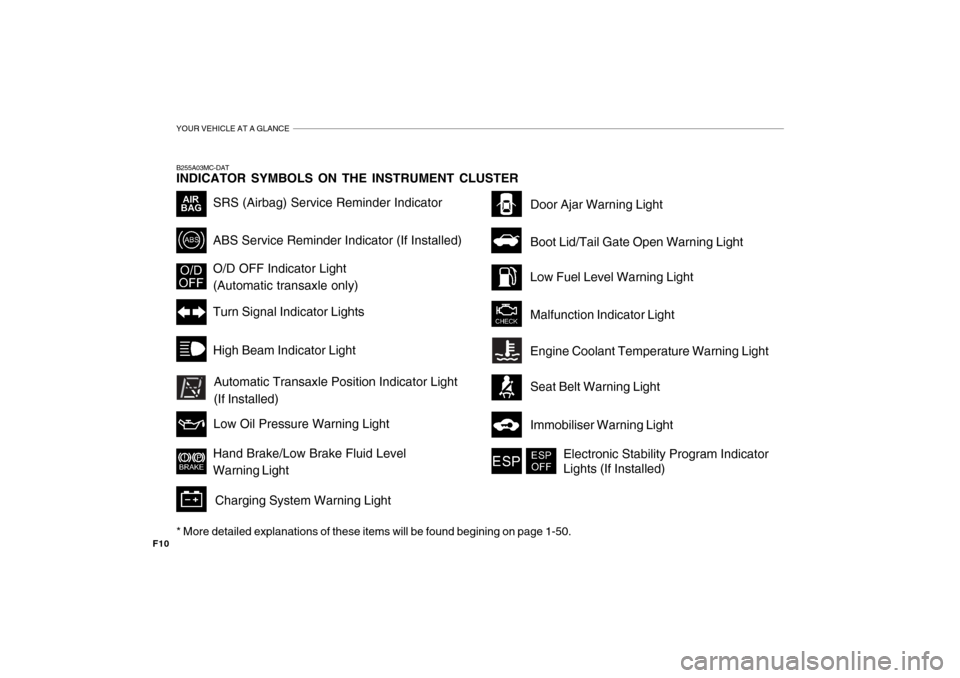
YOUR VEHICLE AT A GLANCE
F10B255A03MC-DAT INDICATOR SYMBOLS ON THE INSTRUMENT CLUSTER * More detailed explanations of these items will be found begining on page 1-50.
Turn Signal Indicator Lights
SRS (Airbag) Service Reminder Indicator O/D OFF Indicator Light (Automatic transaxle only) High Beam Indicator Light
Low Oil Pressure Warning Light
ABS Service Reminder Indicator (If Installed)
Door Ajar Warning Light
Hand Brake/Low Brake Fluid Level Warning Light Charging System Warning Light Low Fuel Level Warning Light Malfunction Indicator Light
Immobiliser Warning Light
Boot Lid/Tail Gate Open Warning Light
Engine Coolant Temperature Warning Light Seat Belt Warning Light
Electronic Stability Program Indicator Lights (If Installed)
Automatic Transaxle Position Indicator Light (If Installed)
Page 12 of 232
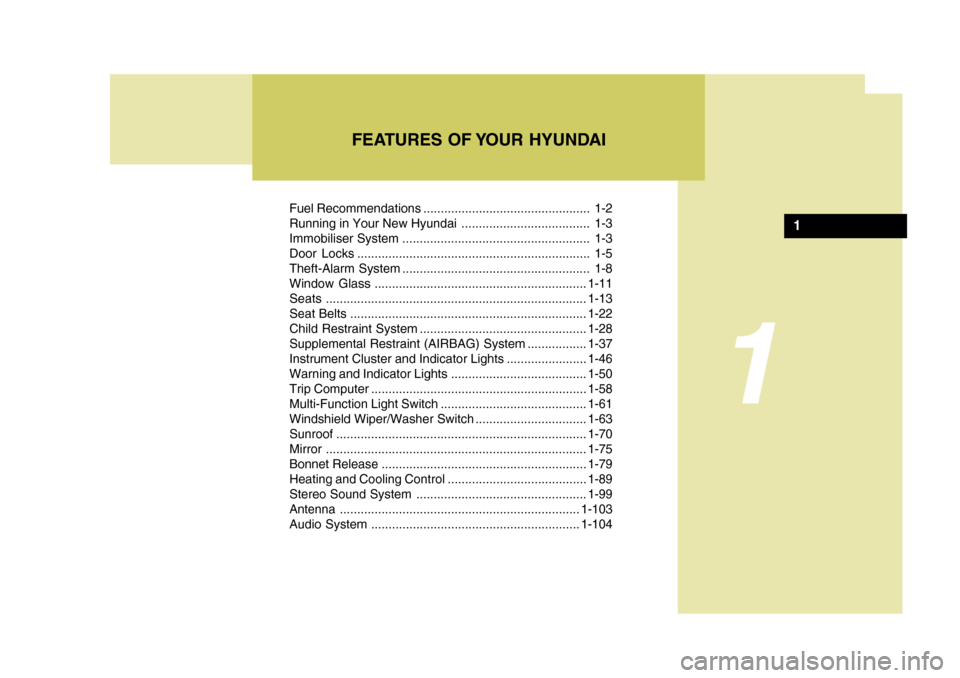
FEATURES OF YOUR HYUNDAI
1
1
Fuel Recommendations ................................................ 1-2
Running in Your New Hyundai ..................................... 1-3
Immobiliser System ...................................................... 1-3
Door Locks ................................................................... 1-5
Theft-Alarm System ...................................................... 1-8Window Glass............................................................. 1-11
Seats ........................................................................... 1-13
Seat Belts .................................................................... 1-22
Child Restraint System ................................................ 1-28
Supplemental Restraint (AIRBAG) System .................1-37
Instrument Cluster and Indicator Lights .......................1-46
Warning and Indicator Lights....................................... 1-50
Trip Computer .............................................................. 1-58
Multi-Function Light Sw itch .......................................... 1-61
Windshield Wiper/Washer Switch ................................1-63
Sunroof ........................................................................ 1-70
Mirror ........................................................................... 1-75
Bonnet Release ........................................................... 1-79
Heating and Cooling Control .......... ..............................1-89
Stereo Sound System ................................................. 1-99
Antenna ..................................................................... 1-103
Audio System ............................................................ 1-104
Page 16 of 232
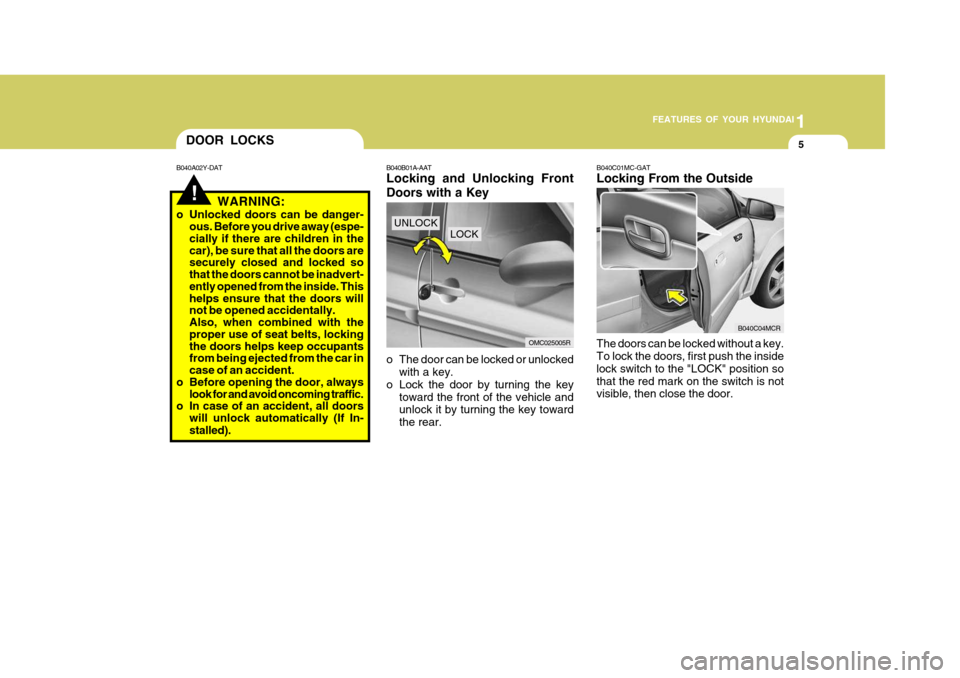
1
FEATURES OF YOUR HYUNDAI
5
!
DOOR LOCKS
B040A02Y-DAT
WARNING:
o Unlocked doors can be danger- ous. Before you drive away (espe- cially if there are children in the car), be sure that all the doors are securely closed and locked so that the doors cannot be inadvert- ently opened from the inside. This helps ensure that the doors will not be opened accidentally. Also, when combined with the proper use of seat belts, locking the doors helps keep occupants from being ejected from the car in case of an accident.
o Before opening the door, always
look for and avoid oncoming traffic.
o In case of an accident, all doors
will unlock automatically (If In- stalled).
OMC025005R B040C01MC-GAT Locking From the Outside The doors can be locked without a key. To lock the doors, first push the inside lock switch to the "LOCK" position sothat the red mark on the switch is not visible, then close the door.
B040B01A-AAT Locking and Unlocking Front Doors with a Key
o The door can be locked or unlocked
with a key.
o Lock the door by turning the key toward the front of the vehicle and unlock it by turning the key toward the rear.
UNLOCKLOCK
B040C04MCR
Page 26 of 232

1
FEATURES OF YOUR HYUNDAI
15
!WARNING:
To minimise risk of severe injury in the event of a collision or a sudden stop, both the driver and passenger seatbacks should always be in anupright position while the vehicle is in motion. The protection provided by the seat belts and airbags in afrontal collision may be reduced sig- nificantly when the seatbacks are reclined. There is greater risk thatthe driver and passenger will slide under the seat belt which may result in serious injury if a crash occurswhen the seatbacks are reclined. The seat belt cannot provide full protec- tion to an occupant if the seatback isreclined.!WARNING:
o For maximum effectiveness in case of an accident, the headrest should be adjusted so the middle of theheadrest is at the same height of the centre of gravity of an occupant's head. Generally, thecentre of gravity of most people's head is similar with the height of the top of their eyes. Also, adjustthe headrest as close to your head as possible. For this reason, the use of a cushion that holds thebody away from the seatback is not recommended.
o Do not operate the vehicle with the
headrests removed as severe in-jury to the occupants may occur in the event of an accident. Head-rests may provide protection against neck injuries when prop- erly adjusted.
o Do not adjust the headrest posi- tion of the driver's seat while thevehicle is in motion.
C010104AMC Headrest
The driver's and front passenger's seats are equipped with a headrest for the occupant's safety and comfort.The headrest not only provides comfort for the driver and front passenger, but also helps to protect the head and neckin the event of a collision. OBH038075L
Page 30 of 232

1
FEATURES OF YOUR HYUNDAI
19
!
B110A02MC-DAT Folding Rear Seatbacks (If Installed) The rear seatbacks may be folded to facilitate carrying long items or to in-crease the luggage capacity of the vehicle.
WARNING:
The purpose of the fold-down rearseatbacks is to allow you to carry longer objects than could otherwisebe accommodated. Never allow passengers to sit on top of the folded down seatback or cargoarea while the car is moving as this is not a proper seating position and no seat belts are available for use.This could result in serious injury or death in case of an accident or sud- den stop. Objects carried on thefolded down seatback should not extend higher than the top of the front seats. This could allow cargo toslide forward and cause injury or damage during sudden stops.
Removal (If Installed) To remove the headrest, raise it as far as it can go then press the release button (1) while pulling upward (2). To reinstall the headrest, put the head-rest poles (3) into the holes while press- ing the release button (1). Then adjust it to the appropriate height.
OMC029046
!WARNING:
Make sure the headrest locks in po- sition after adjusting it to properly protect the occupants.
To fold down the seatback :
1. Slide the front seats forward and adjust the front seatbacks to be up- right before folding the rear seatbacks down.
2. Lower the rear seat headrests to the lowest position.
CAUTION:
!
B220D05MC
o In order to prevent the centre shoulder belt from being dam- aged while folding the rear seat,disconnect the metal tab (A) from the buckle (B).
Page 31 of 232
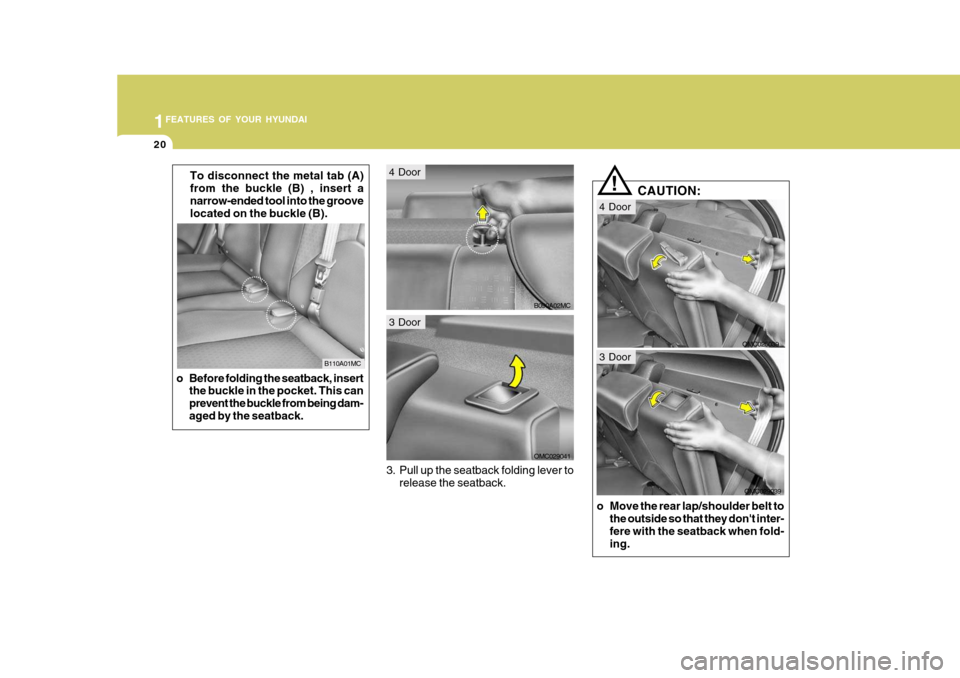
1FEATURES OF YOUR HYUNDAI
20
CAUTION:
!
o Move the rear lap/shoulder belt to the outside so that they don't inter- fere with the seatback when fold- ing.To disconnect the metal tab (A) from the buckle (B) , insert a narrow-ended tool into the groove located on the buckle (B).
3. Pull up the seatback folding lever torelease the seatback.
B110A01MC
B090A02MC
OMC029041
4 Door
3 Door
OMC025039
OMC029039
4 Door
3 Door
o Before folding the seatback, insert the buckle in the pocket. This can prevent the buckle from being dam-aged by the seatback.
Page 32 of 232
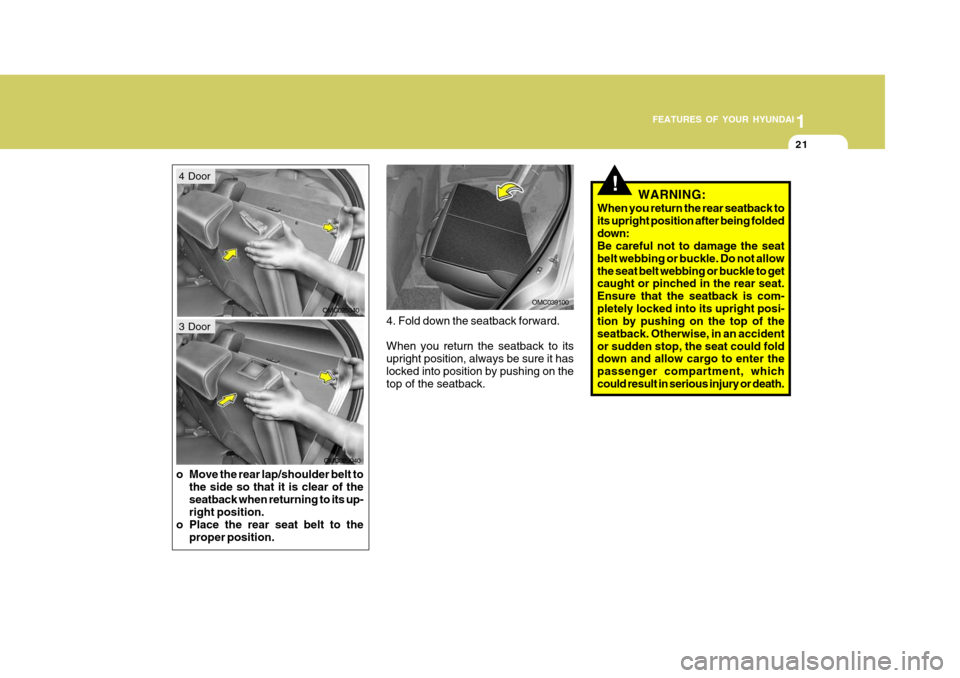
1
FEATURES OF YOUR HYUNDAI
21
o Move the rear lap/shoulder belt to
the side so that it is clear of the seatback when returning to its up- right position.
o Place the rear seat belt to the proper position. 4. Fold down the seatback forward. When you return the seatback to its upright position, always be sure it has locked into position by pushing on thetop of the seatback.
OMC025040
OMC029040
4 Door
3 Door
OMC039100
!WARNING:
When you return the rear seatback to its upright position after being foldeddown: Be careful not to damage the seat belt webbing or buckle. Do not allowthe seat belt webbing or buckle to get caught or pinched in the rear seat. Ensure that the seatback is com-pletely locked into its upright posi- tion by pushing on the top of the seatback. Otherwise, in an accidentor sudden stop, the seat could fold down and allow cargo to enter the passenger compartment, whichcould result in serious injury or death.
Page 33 of 232
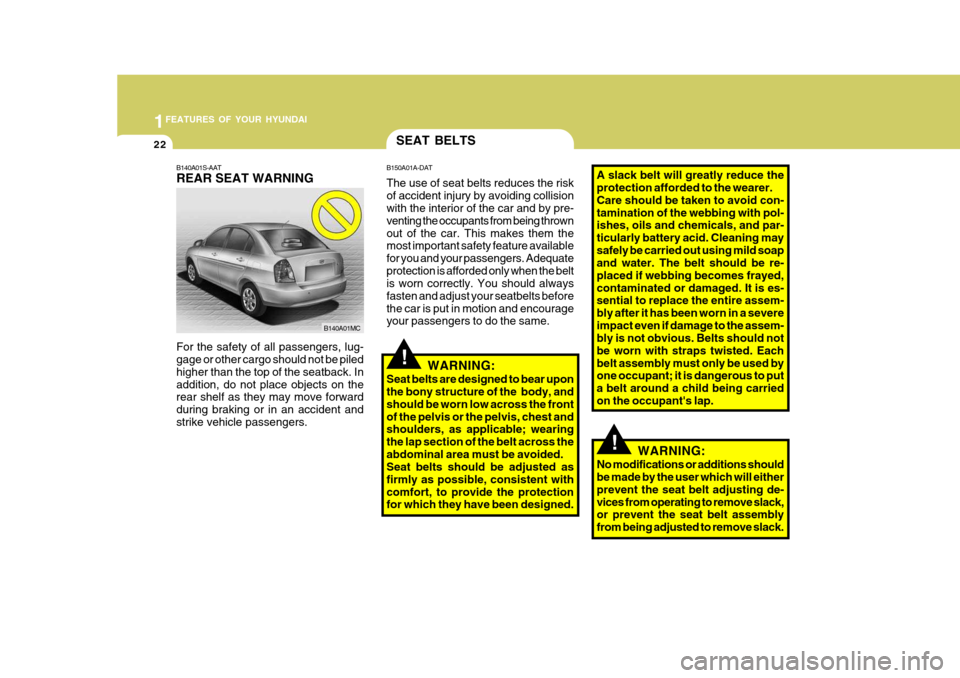
1FEATURES OF YOUR HYUNDAI
22
B140A01S-AAT REAR SEAT WARNING For the safety of all passengers, lug- gage or other cargo should not be piled higher than the top of the seatback. Inaddition, do not place objects on the rear shelf as they may move forward during braking or in an accident andstrike vehicle passengers.
B140A01MC
!
!
SEAT BELTS
B150A01A-DAT The use of seat belts reduces the risk of accident injury by avoiding collision with the interior of the car and by pre- venting the occupants from being thrownout of the car. This makes them the most important safety feature available for you and your passengers. Adequateprotection is afforded only when the belt is worn correctly. You should always fasten and adjust your seatbelts beforethe car is put in motion and encourage your passengers to do the same.
WARNING:
Seat belts are designed to bear uponthe bony structure of the body, and should be worn low across the frontof the pelvis or the pelvis, chest and shoulders, as applicable; wearing the lap section of the belt across theabdominal area must be avoided. Seat belts should be adjusted as firmly as possible, consistent withcomfort, to provide the protection for which they have been designed. A slack belt will greatly reduce theprotection afforded to the wearer. Care should be taken to avoid con-tamination of the webbing with pol- ishes, oils and chemicals, and par- ticularly battery acid. Cleaning maysafely be carried out using mild soap and water. The belt should be re- placed if webbing becomes frayed,contaminated or damaged. It is es- sential to replace the entire assem- bly after it has been worn in a severeimpact even if damage to the assem- bly is not obvious. Belts should not be worn with straps twisted. Eachbelt assembly must only be used by one occupant; it is dangerous to put a belt around a child being carriedon the occupant's lap.
WARNING:
No modifications or additions should be made by the user which will either prevent the seat belt adjusting de-vices from operating to remove slack, or prevent the seat belt assembly from being adjusted to remove slack.